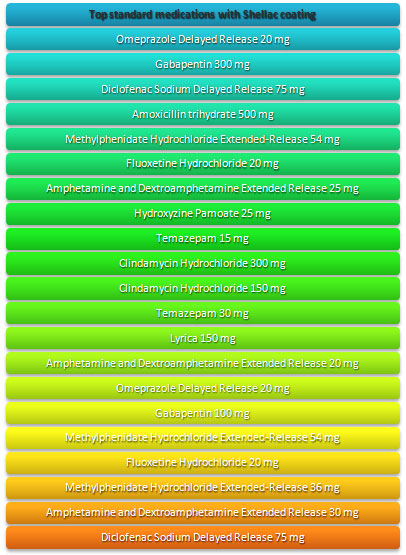
SHELLAC- the name is known by many as an efficient and versatile polymer widely used to coat furnitures, food, fruits, etc. It’s also used as taste masking agent. Pharmaceutical and neutraceutical industries are utilising Shellac since several years for the providence of multiple functional properties.
-
- The reports are as follows:
- National Formulary (NF) has recognized Shellac.
- It is listed in:
- Japanese Pharmacopoeia
- European Pharmacopoeia
- Food Chemicals Codex
- The United States Pharmacopeia
- In European Food Regulations it is noted as E904.
- The United States and Europe has approved Shellac as a food additive.
- FDA has designated Shellac as safe (GRAS).
- The reports are as follows:
Let’ s be familiar with the structural components of Shellac:
Shellac is structurally composed of:
- Esters from polyhydroxyl carboxylic acids
- Polar and non polar components (within the molecule)
- Again, there are 4 main components of carboxylic acid:
- Aleuritic (35%)
- Jalaric (25%)
- Shellolic (8%)
- Butolic (8%)
The enteric coatings contain polymers with the acidic functional groups. The shellac becomes water-soluble in the stomach as the acid groups are protonated in the acidic environment.
- How can Esterification be inhibited?
Ans: Using specific plasticizers
Shellac’s flexibility is improved by the combination of surfactants and plasticisers. Moreover, it raises the film’s adhesive structural reinforcement properties. Specific formulations like Sensient, Protect EN, etc. have been proven effective in the matter of functional reproducibility and product stability over time.
Finally, with the addition of sodium alginate, the entire enteric system of film-coating offers gastric protection along with quality film adhesion and flexibility for the capsules, particles, tablets, etc.
- Coming to the enteric functionality of Shellac:
It is used for producing films with the earmark functionality for meeting the desired dosage release with the digestive tract’s physiological ranges (pH).
- Presenting you a table of an Anatomical pH:

- Comparison between Shellac and HPMC (Hydroxypropyl Methylcellulose):
The comparison between the two is made owing to the character of achieving moisture protection and taste masking.

- It is proved that the resulting drug release in the simulated gastric fluid is not notably changed in character or composition by the thin shellac coatings that quickly ruptured because of the coated tablet core’s swelling.
- Shellac is an acceptable matrix former for the extended-release tablets.
- Shellac is a potential pharmaceutical excipient.
- Let us be knowledgeable with the:

- Median Lethal dose for Shellac:
More than 5 grams per kg (kilogram)
- Is there any probable toxicity resulted from Shellac?
- Studies considering animals show no adverse effects from the dermal, oral, respiratory tract or ocular exposure to the formulations having up to 6% of Shellac.
- Irritation, sensitisation, photosensitisation, mutagenicity is not observed in the clinical analysis of the cosmetic formulations that contain up to 6% of shellac.
Hitherto, according to medical science shellac is okay to consume without any harmful effects as such on our physical and mental health. We can say “Shellac” is the life- time enhancer and taste booster of the pharma world.

